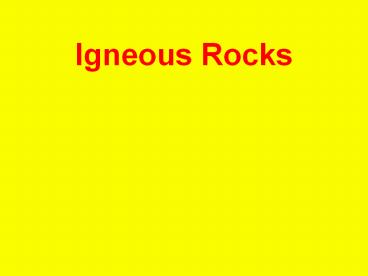Igneous Rocks - PowerPoint PPT Presentation
1 / 37
Title:
Igneous Rocks
Description:
Phaneritic: Gabbro. Phaneritic = grains large enough to be seen with the naked eye. ... basalt gabbro. andesite diorite. rhyolite granite ... – PowerPoint PPT presentation
Number of Views:66
Avg rating:3.0/5.0
Title: Igneous Rocks
1
Igneous Rocks
2
Igneous rocks
- Formed from the cooling and
- consolidation of magma.
- Plutonic (intrusive) cooled below the
surface. - Volcanic (extrusive) cooled on the surface.
3
Magma vs Lava
- Magma A mass of molten rock below the surface
of the Earth. - Lava Molten rock above the surface of the Earth.
4
Macroscopic vs. microscopic
Magnifying glass
1 cm
Microscope
1 mm
Figure 5.1
5
Igneous textures
- Classifying based on crystal size .
- Glassy no crystals
- Aphanitic rocks made of microscopically small
crystals - Phaneritic grains large enough to be seen with
the naked eye - Porphyritic mixture of coarse and fine
- Vesicular with bubble holes
- Pyroclastic formed of ash, glass, and mineral
fragments blown into the air by volcanic
explosion
6
Glassy Obsidian
Glassy no crystals.
7
Aphanitic Rhyolite
Aphanitic crystals too small to be seen with
the naked eye.
8
Phaneritic Gabbro
Phaneritic grains large enough to be seen with
the naked eye.
9
Porphyritic
Porphyritic mixture of coarse and fine grains.
10
Vesicular Pumice
Vesicular with bubble holes.
11
Pyroclastic
Pyroclastic formed from ash, glass shards, and
mineral fragments thrown into the air by a
volcanic eruption.
12
What controls texture?
How fast an igneous rock cools.
What controls how fast an igneous rock cools?
The setting where the rock is formed.
In general,
13
Formation and texture
1. Pyroclasts form from airborne lava in violent
eruption
2. Extrusive igneous rocks. Cool rapidly on the
Earths surface
3. Intrusive igneous rocks. Cool slowly in the
Earths interior allowing large crystals to form
4. Porphyry starts to grow below the surface but
before solidification is brought to the surface
Figure 5.3
14
Mafic vs felsic?
- Extrusive Intrusive
- Volcanic Plutonic
- Fast-cooling Slow-cooling
- Fine-grained Coarse-grained
- basalt gabbro
- andesite diorite
- rhyolite granite
It turns out there are two major ways of
classifying igneous rocks. Weve already seen
one, classification by texture
Theres also classification by composition
- magnesium (Mg) iron (Fe) mafic
- feldspar quartz (Si) felsic
15
Table 5-1
16
Composition of Igneous Rocks
- When we talk about the chemical composition of a
rock we usually speak in terms of the weight
percent oxides, e.g., - Typical Typical
basalt granite - SiO2 50 70
- Al2O3 15 12
- FeOMgO 15 3
- CaO 8 2
- K2ONa2O 5 8
17
Classification of Igneous Rocks
Mafic minerals crystallize at higher
tempera-tures (earlier in the cooling of a magma)
than felsic minerals.
Figure 5.4
18
How do rocks melt?
- Melt a whole rock, and the composition of the
melt will be the same as the composition of the
whole rock. - However, whole melting is the exception!
- Most rocks undergo partial melting.
- In partial melting, different minerals
melt at different times
(have different
melting points). - Composition of the liquid is different
from the composition of the
residual solid. - Like a melting a chocolate chip cookie
(melt to the point that the
chips melt
but the rest of the cookie is intact).
19
How do rocks melt?
- Melting takes place when material rises to the
surface (effect of decreasing pressure). - Melt is more buoyant than the residual rock, so
it rises to the surface.
20
Factors affecting melting temperatures (Table 5.3)
21
More on pressure .
- Squeeze water hard, and it will freeze!
- Rocks work the same way.
- Pressure increases with depth in the Earths
interior. - Rocks which will melt at 1000C at the surface
will melt at 1300C in the interior.
22
Even more on pressure .
- Under a mid-ocean ridge, temperature doesnt
change much with depth, but pressure does. - Decompression melting.
Figure 1.11
23
Tectonic Settings of Igneous Activity
Figure 5.11
24
Volcanic Island Arc, Indonesia
25
Oceanic Hot Spot
Hawaii
26
Lava flow at Volcanoes National Park,
Hawaii
27
Continental Volcanic ArcN. Cascades
28
Types of Igneous Structures
Figure 5.7
29
Some definitions
- Pluton Large igneous body formed deep within
the Earths crust. - Batholiths The largest plutons (at least 100
km2). - Stocks Smaller plutons.
- Sill Tabular, sheetlike body formed by the
injection of magma between layers of rock. - Dike Tabular igneous bodies that cut across
layers of rock. - Country rock Rock surrounding an igneous
intrusion.
30
Figure 5.9
Sill
31
Dike
Figure 5.9
32
Mid-ocean ridge magmatism
Figure 5.13
33
Subduction zone magmatism
Figure 5.14
34
Subduction zone magmatism
Figure 5.15
35
Mt. Rainier
36
Fractional crystallization
- The process of crystallizing and removal of
crystals from the magma. - Composition of crystals is different than magma.
- Fractional crystallization results in chemical
change in the magma. - High temperature minerals crystallize first
(melt last).
37
Bowens Reaction Series
- Kind of a mirror image of partial melting.
- As magma temperature decreases, minerals
crystallize out of the melt in an - ordered sequence.
- Two series Mafic and felsic.
Figure 5.5































